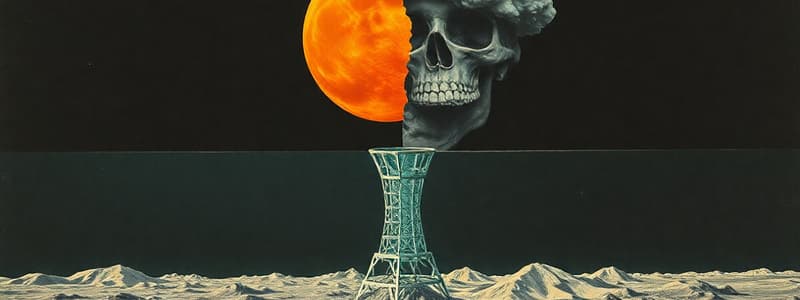Podcast
Questions and Answers
An ideal gas undergoes an expansion. In a pV diagram, the initial state is (10, 1), and the final state is (5,2). What is the sign of the work done on the gas?
An ideal gas undergoes an expansion. In a pV diagram, the initial state is (10, 1), and the final state is (5,2). What is the sign of the work done on the gas?
- The work done on the gas is zero.
- The work done on the gas is positive.
- The work done on the gas is negative. (correct)
- It cannot be determined from the information given.
A system undergoes a process in which 500J of heat is added and 200J of work is done on the system. What is the change in internal energy of the system?
A system undergoes a process in which 500J of heat is added and 200J of work is done on the system. What is the change in internal energy of the system?
- -700J
- -300J
- 700J (correct)
- 300J
A substance is heated from a solid state, through its melting point, entirely into a liquid state with no further change in temperature. Which of the following is true about the heat transfer during the phase change?
A substance is heated from a solid state, through its melting point, entirely into a liquid state with no further change in temperature. Which of the following is true about the heat transfer during the phase change?
- The heat transfer is negative during the phase change.
- The heat transfer is undetermined during the phase change.
- The heat transfer is positive during the phase change. (correct)
- The heat transfer is zero during the phase change.
The temperature of a 2kg block of a solid is increased from 20$^{\circ}$C to 40$^{\circ}$C. The specific heat of the solid is 500 J/(kg$\cdot$$^{\circ}$C). What is the amount of heat transfer during this process?
The temperature of a 2kg block of a solid is increased from 20$^{\circ}$C to 40$^{\circ}$C. The specific heat of the solid is 500 J/(kg$\cdot$$^{\circ}$C). What is the amount of heat transfer during this process?
Consider a system of ice at 0$^{\circ}$C that gradually melts into water at 0$^{\circ}$C. How should the energy flow diagrams be constructed to represent this process?
Consider a system of ice at 0$^{\circ}$C that gradually melts into water at 0$^{\circ}$C. How should the energy flow diagrams be constructed to represent this process?
Flashcards
Ideal Gas Law
Ideal Gas Law
The law describing the relationship between pressure, volume, temperature, and the number of moles of an ideal gas. It states that PV = nRT, where P is pressure, V is volume, n is the number of moles, R is the ideal gas constant, and T is temperature.
pV Diagram
pV Diagram
A diagram showing the relationship between the pressure and volume of a gas during a thermodynamic process. It can help visualize changes in energy and work done by the gas.
Specific Heat
Specific Heat
The amount of heat energy required to raise the temperature of 1 gram of a substance by 1 degree Celsius.
Heat of Transformation
Heat of Transformation
Signup and view all the flashcards
Energy Flow Diagram
Energy Flow Diagram
Signup and view all the flashcards
Study Notes
Ideal Gases
- Create and interpret energy flow diagrams for multi-step processes involving ideal gases
- Relate diagram information to the First Law of Thermodynamics and a corresponding pV diagram
- Apply ideal gas law and First Law calculations or reasoning with pV diagrams and associated energy flow diagrams
- Use pV diagrams to calculate work done on an ideal gas
- Determine if work done on the gas is positive, negative, or zero
Phase Change, Specific Heat
- Sketch a temperature vs. heat transfer (T vs. Q) graph for a substance changing phases
- Explain what's happening at different temperature regions of the graph (mixture of phases)
- Interpret and create series of energy flow diagrams showing processes involving phase changes
- Write heat transfer expressions corresponding to each step in energy flow diagrams, including heating/cooling of single or multiple phases
- Apply specific heat concepts for a single phase of matter and heat of transformation for phase change to calculate heat transfer amounts.
Studying That Suits You
Use AI to generate personalized quizzes and flashcards to suit your learning preferences.




